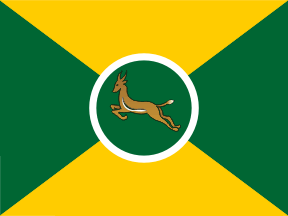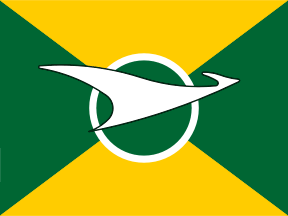
This page is part of © FOTW Flags Of The World website
South African Railways and Harbours (1916-1981)
(SAR & H)
Last modified: 2015-08-21 by bruce berry
Keywords: south african railways and harbours |
Links: FOTW homepage |
search |
disclaimer and copyright |
write us |
mirrors
 image
by Martin Grieve, 24 Mar 2004
image
by Martin Grieve, 24 Mar 2004
See also :
Background
On
31 May 1910 four British colonies of Natal,
Cape Colony, Orange River Colony and
Transvaal amalgamated to form the
Union of South Africa. All the railways
in South Africa became part of a unified state-owned railway system in 1916 when
the Central South African Railways, the Cape Government Railways and the Natal
Government Railways were all merged by an Act of Parliament. Thus was born the
South African Railways and Harbours (SAR&H). Later, when commercial
aviation developed, South African Airways also became a part of this huge land,
sea and air transport system.
In 1981 the South African government decided that the SAR&H should
restructure itself along business lines in order to evolve from a state-owned
corporation towards privatisation. Integral to the process was a change in
the name and image of the organisation, which would reflect its new mission as a
state business enterprise. In April 1981, the railway, harbour, road transport,
aviation and pipeline operations became known as South African Transport
Services (SATS). At the same time, the enterprise was restructured into
units and divisions with strong emphasis on localised management.
During the following decade, SATS consolidated. It identified and established
core businesses and discontinued some services with a key goal being a reduction
in staff. The single largest reduction came about when the
South African
Railways Police was divorced from SATS and absorbed into the
South African
Police.
The "Legal Succession to the South African Transport Services Act, 1989"
transformed the South African Transport Services from a government department
into a public company and on 01 April 1990, after 80 years of government and
parliamentary control, SATS received company status. A new company representing
a vast transportation network was born under a company named TRANSNET.
Transnet Limited is a public company of which the South African Government is
the sole shareholder. It is the holding company behind South Africa's largest
transport businesses and consists of eight major divisions - Spoornet, the Ports
Authority, Port Operations, Freight Dynamics, Petronet, Metrorail, Propnet,
Transtel, as well as a number of related and support businesses.
Bruce Berry, 24 Mar 2004
South African Railways and Harbours (SAR & H)
Some time ago, whilst browsing through some old flag books at my local library I came upon a copy of "Flags of the
World" by Barraclough (1965 edition). Upon turning to the pages dealing with South Africa, there on page 221
appeared a black and white outline drawing of the house flag of the South African
Railways and Harbours Administration along with the following description:
"The House flag of the South African Railways and Harbours Administration has a field four by three and is quartered diagonally, green and gold
(green at the hoist and the fly); superimposed on the centre is a white-edged green disc
charged with a springbok in natural colours".
Martin Grieve, 24 Mar 2004
Jarig Bakker has very kindly sent me a scan from Loughran's "A Survey of Mercantile House flags &
Funnels" (1979) which shows two flags - one being very similar to that
shown above, and the other
showing the same basic design, but with what appears to be a flying Springbok replacing the
earlier version in the disc.
 image by Martin Grieve, 24 Mar 2004
image by Martin Grieve, 24 Mar 2004
Jarig also included the text from the book:
"The South African Railways & Harbours Administration have quite handsome markings, the flag originally embodying a Springbok which
was replaced by a more modern symbol. The funnels remained the same."
My thanks to Jarig for partially clearing the mystery of dates but two questions
remain:
1. In what year was the first flag adopted?
2. In what year was the second flag abolished?
Martin Grieve, 24 Mar 2004
An additional item of information about the SAR&H flag (the one with the
conventional Springbok) : the SAR&H registered it under the Merchandise Marks
Act 1941 in 1946, as protection against unauthorised use (Government Gazette
3739 (20 December 1946).
Arthur Radburn, 29 May 2015
 image by Martin Grieve, 24 Mar 2004
image by Martin Grieve, 24 Mar 2004
 image
by Martin Grieve, 24 Mar 2004
image
by Martin Grieve, 24 Mar 2004